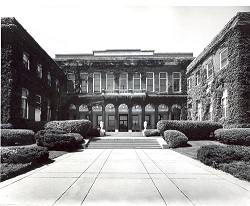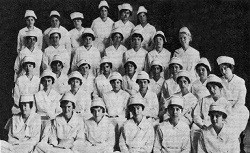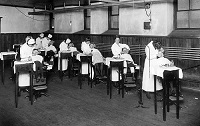The School for Dental Hygienists
 In 1915, George Eastman donated funds to build a dental dispensary, with the purpose of providing oral health care to the indigent children of Rochester. Eastman agreed to fund the dispensary if the city schools provided support for dispensary staff to visit the schools and clean the children's teeth twice a year. Eastman believed in preventive dentistry; his own oral health suffered and he recalled watching his mother have fourteen teeth pulled.
In 1915, George Eastman donated funds to build a dental dispensary, with the purpose of providing oral health care to the indigent children of Rochester. Eastman agreed to fund the dispensary if the city schools provided support for dispensary staff to visit the schools and clean the children's teeth twice a year. Eastman believed in preventive dentistry; his own oral health suffered and he recalled watching his mother have fourteen teeth pulled.
Dispensary director Dr. Harvey Burkhart realized that in order to carry out Eastman's mission, he would need to hire dental hygienists. However, there were few hygienists in the area and no schools to train young woman for this work. This was a common problem throughout the country because the practice of dentistry was moving from rescue and repair towards prevention. In a lecture given at the annual meeting of the Maryland State Dental Association, Burkhart noted, “we find ourselves in the peculiar situation of having created a demand for service that cannot at present be supplied.”1
With Eastman's approval, Burkhart applied for and received permission from the New York State Board of Regents to establish a school for dental hygienists. The School for Dental Hygienists officially opened on October 9, 1916.
 The school was temporarily housed at Catherine Strong Hall until construction of the Rochester Dental Dispensary was complete. The first principal was Dr. Burkhart and the girls were supervised by matron Bessie Miller. There were 40 students in the first class.
The school was temporarily housed at Catherine Strong Hall until construction of the Rochester Dental Dispensary was complete. The first principal was Dr. Burkhart and the girls were supervised by matron Bessie Miller. There were 40 students in the first class.
 The original program was an eight month course taught by local doctors and dentists. In the afternoons, students were divided into squads and bused to public schools with a supervising dentist. They also practiced on children at local orphanages and on employees of Eastman Kodak.
The original program was an eight month course taught by local doctors and dentists. In the afternoons, students were divided into squads and bused to public schools with a supervising dentist. They also practiced on children at local orphanages and on employees of Eastman Kodak.
Most of the students moved away from their families to attend school; thus they formed a close bond with one another. They attended banquets, picnics, parties and teas, and even convinced Dr. Burkhart to purchase a piano for their frequent dances. 
The School for Dental Hygienists earned a national reputation and was discussed at conferences, in newspapers, and in professional publications. It served as a model for future schools and was the first of its kind in the United States to be recognized by a state authority. As the profession gained momentum, the American Dental Hygienists Association was formed; alumnus Edith Hardy was the first president elect.
The 1940's brought forth a change in leadership for the school and the Rochester Dental Dispensary. Dr. Basil Bibby became the second director, Dr. Ruth Vann the Dean of students, and Deborah Hardy the matron.
This was a period of tremendous growth for the dental hygiene profession, as evident in the establishment of accreditation standards, licensure, and interest in dental research. These changes created a need for more space, an expanded curriculum, and better housing. In 1958 a building was purchased near the dispensary to be used as a dorm and Madelyn Birrell was hired as the girls' house mother.
By the 1960's the School for Dental Hygienists was the only school in the United States that was not affiliated with a college. Although the school was accredited in 1962, it was becoming more difficult to accommodate the growing program. In 1964, after discussions between Eastman Dental trustees, Dr. Bibby, and Monroe Community College, the school was transferred to Monroe Community College where it became a two-year program that resulted in an A.A.S. degree.
In 1965, after 49 years, the school graduated its final class.
Inventory
Originally housed at Bibby Library, contents of the Eastman Dental Center Archives are available from the Rare Books & Manuscripts Department of Miner Library. Rare books, manuscript collections, historical photographs, etc. may be used under supervision during departmental hours.
A detailed inventory of the files pertaining to the School for Dental Hygienists is provided at the Eastman Dental Center Archives webpage, Series 5. Boxes 1-10: Departments.
Boxes 5-8 in this series contain material pertaining to the School for Dental Hygienists from 1916 through 1964. These materials include the School’s annual catalogs (1916-ca. 1955), commencement programs, yearbooks (1920-1930), newspaper clippings, etc. Photographs of students, etc. are contained in Series 7.
1. Burkhart, H. (1927). The dental hygienist in school and institutional work and in private practice. The Dental Cosmos; a Monthly Record of Dental Science., 69(2), 172.
More Information
- School for Dental Hygienists 1957-1960
- School for Dental Hygienists: The Wood Family
- School for Dental Hygienists: Images, documents, yearbooks
- Historical Collections